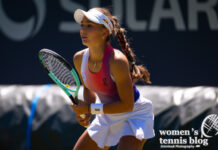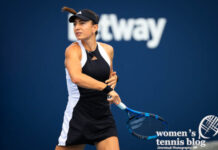Players have to be ready to quickly react to their opponent’s shots numerous times. They have around one second to set up their body and racquet and execute a controlled shot. Tennis coach Marcin Bieniek, founder of Enjoy Tennis Blog, explains why half volley from the baseline is one of the shots that players should practice to be able to deal with time pressure.
Modern game is a fast game
If we take a look at the strokes, players hit the ball harder than ever before. Advanced racquets, a more specific physical approach and also a fluent technique allow players to hit the ball really hard and consistently into the court. The more skills players have, the better they can adapt to a changing environment.
Surface is also a factor that makes the game much faster. Most tournaments are played on hard courts, so players get used to competing on surfaces where there is little time to think and react. Of course, there is still a variety of game styles that players present, but successful players understand that they will have to deal with many uncomfortable situations over the course of the match and they have to be prepared for them.
The importance of half volley in today’s tennis
One of the skills that is of utmost importance is to possess a half volley from the baseline. This shot is played many times while responding to a really hard ball or while receiving deep returns right after the serve. When a player doesn’t have time to move back, half volley is the best option to stay in point and to not give advantage to the rival.
Agnieszka Radwanska in the past and now Iga Swiatek are the best examples of players who use half volley really well. Learning from professional players is always an asset, but conscious actions have to be incorporated into training sessions to possess necessary skills to execute this complex shot.
Training session is a place where tennis players have to develop skills that they will need in competition. It is important to work not only on skills that we feel good with but also to take a broader perspective and start working on skills that we will need to use against particular types of opponents or on particular surfaces.
How to hit the half volley
1) Technical aspects of half volleys
From a technical point of view, you have to make some adjustments to increase the chance of executing a successful half volley. Because the ball is deep and mostly hard played, you shouldn’t focus on generating your own pace but rather control the pace of the incoming shot and hit it back with the same power.
To achieve this task, you should take a shorter backswing and focus just on the point of contact in front of your body. Additionally, because the point of contact is really low, you should bend knees really low to maintain a balanced position. Wide and low stances are hallmarks of successful half volleys and sometimes we can even see players having to sit on the ground after this shot because of the deep bend that they execute.
2) Tactical nuances to minimize opponent’s chances
You already know that your tactical goal should be to play with the power of the incoming ball. If you try to hit half volley with additional power, you will significantly increase a chance of committing an error.
The goal of hitting the ball right after the bounce is to not move back behind the baseline and also to not give advantage to the rival in the next attempt. It means that you should aim low over the net to make the response difficult to attack and also to give opponent less time to prepare the next offensive response.
These balls can safely be directed deep to the center court but can also be used as a regular weapon to change direction or move the rival while aiming to the side zones of the court.
3) Strong mental game: Learn to hit a half volley under pressure
The mental aspect has to be included in all the skills that we try to develop. While working on half volleys, you have to be sure that you will feel comfortable executing this shot under the pressure of competition. That is why you have to practice this response in simulated games, in order to be able to make automatic decisions and trust your execution.
You can play cross-court games when you have to stay inside the court or you can play serve + 1 pattern when the opponent returns deep to the center and you have to direct a half volley into specific big targets. Learning how to control your nerves and think about the execution, not the score, are crucial mental steps to allow successful performance during tournaments.
Conclusion
The game of tennis is constantly evolving, so we can’t be 100% sure what it will look like in the near feature. What we can control are our daily actions and skills that we work on to improve our performance. It is recommended to develop a variety of skills right now, half volleys included, to make sure that we won’t be surprised in the next months when an opponent comes up with challenging shots and tactical decisions.
To learn more from coach Marcin Bieniek, join his on-demand video training program and get a 30% discount with the code WTBPROMO. Also, visit our Tennis Tips page to learn how to improve specific shots and skills, handle pressure, adapt your game to all surfaces and weather conditions, and much more.




